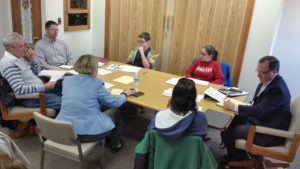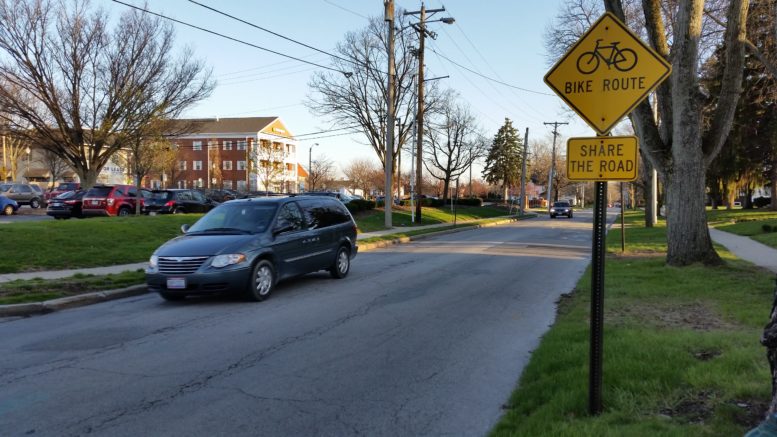By JAN LARSON McLAUGHLIN
BG Independent News
City Engineer Jason Sisco was troubled by the lack of bike route rules in the Complete Streets concept.
“Engineers, we like standards,” he said.
So Sisco shifted gears and did the next best thing – talked to people who frequently bicycle on Bowling Green streets.
The city’s Bicycle Safety Commission met with Sisco Tuesday evening to work on the Complete Streets project, with the goal of making transportation safe for all modes of traffic.
The commission discussed two main topics in order to create a new map designating bike routes around the city.
First, which streets should be designated bike routes?
“We can’t build bike paths everywhere,” Sisco said.
And second, what type of accommodations should be made for bicyclists on those streets?
The options include bike paths, which are paved areas separate from the roadway; bike lanes, which are lanes specifically for bikes along the edge; or sharrows, which use paint on the pavement to remind motorists to share the road with bicyclists.

Bicycle Safety Commission meets with city engineer.
Sisco presented four different maps that already designate various “bike routes” across the city. The Complete Streets concept is intended to take that a step further and make the streets safer for cyclists.
The new map will focus on getting cyclists to destinations, like schools, parks, the university, and shopping.
“Let’s try to do something that makes sense and is attainable,” Sisco said.
The routes will be designed to get a 10-year-old to school, a family to the park, and a college student to classes, suggested Parks and Recreation Director Kristin Otley.
Many roadways in the city have no berm for bicyclists. Sisco cautioned that provisions for cyclists will encroach on some sacred cows for many city residents. Making room for bikes means taking room from front yards, street parking or trees.
The easiest way to free up space on some roadways would be to get rid of the street parking. “But it’s going to make people mad,” Sisco said. “We can’t accommodate every interest at the same time.”
The commission members asked that possible solutions not be scrapped just because they don’t fit perfectly. For example, even though some streets won’t have room for a standard three-foot wide bike lane, even a one-foot lane would make cyclists more comfortable.
“We can do some narrowing,” Sisco said of the car lanes, which would allow shoulder space for bikes.
Sisco asked for an estimate of how many people in the community bicycle to work.
“You have your diehards,” who cycle in any weather, Otley said. Then there are fair weather bikers.
Commission member Rob Kleine said it was the “chicken and egg” dilemma. “If access were easier and people felt safer,” more would cycle, he said.
“If you build it, they will come,” said Eileen Baker, a member of the bike commission.
Citizen Penny Evans also predicted more people would ride if they felt safe to do so. “I think sharing the same space (with cars) really isn’t safe.”
“We’ve spent a lot of time saying we can’t do things because they’re expensive,” Evans said. But becoming a “bicycle friendly” city will benefit the community.
Sisco mentioned that cyclists don’t help their cause by not obeying the rules of the road. “I see bicyclists all the time who don’t follow any traffic devices,” he said.
Baker agreed. “Bicyclers don’t do themselves a service by physically breaking the rules. It ticks people off. We make a bad name for ourselves as cyclists doing those things.”
However, Baker also pointed out that motorists aren’t much better. “We all break the law when we drive.”
Members of the cycling commission will come to their next meeting April 19, at 6 p.m., with suggestions for the new bike route map.
Sisco warned that some of their suggestions may not be possible.
“We need your help, but we also need your understanding that there are some constraints,” he said.

